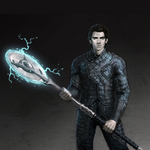Background:
Much of the below is cribbed from Infogalactic:
On October 2 of 1918, near the end of WWI, American forces of the 77th division led by Major Charles White Whittlesey advanced into the Argonne forest as part of a planned offensive. They advanced, reaching their objective at Hill 198, a defensible position, but, the French forces expected on their left flank and the other American forces on their right were stalled, driven back by a counterattack, and so at the end of the day, the 77th discovered it was alone, surrounded, beyond allied lines.
The 77th spent the next day trying to re-establish contact, but could not. Patrols caught all of the messengers sent, and carrier pigeons became the only method of communication. The Germans, for their part, at first believed they were outnumbered, and did not yet attack until later that day. The Germans had no choice but to take them out – leaving the 77th free to advance into the rear would have been disastrous.
Food was short. Water was only available by crawling under machine gun fire to reach a stream. Supplies intended for them were reportedly dropped on the Germans instead. They could not break free, and could not communicate reliably with allied forces. A mistake in the artillery coordinates caused Allied artillery to fall on them, until their last pigeon, Cher Ami, was sent delivering a followup message, “WE ARE ALONG THE ROAD PARALLEL (sic) 276.4. OUR ARTILLERY IS DROPPING A BARRAGE DIRECTLY ON US. FOR HEAVENS SAKE STOP IT”.Not even refusing all calls to surrender, but flat out not even replying, the 77th fought with rifle, grenade, and bayonet to hold their strategically critical position, until finally relieved several days later.
Music:
This is actually two tracks. “Diary of an Unknown Soldier” and “The Lost Battallion” – the first a very short spoken piece that could have occurred anywhere in the Argonne offensive, building up to the driving, slow, heavy drumbeat of “The Lost Battallion” itself, and it’s choral – style opening. The song itself is classic Sabaton: grim, steady, determined, with soaring chorals. In tone it fits the unrelenting meat grinder of WWI trench warfare.

